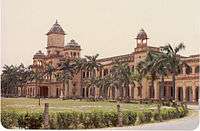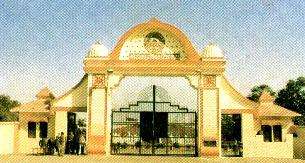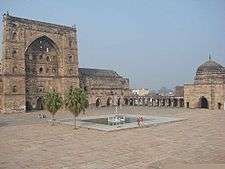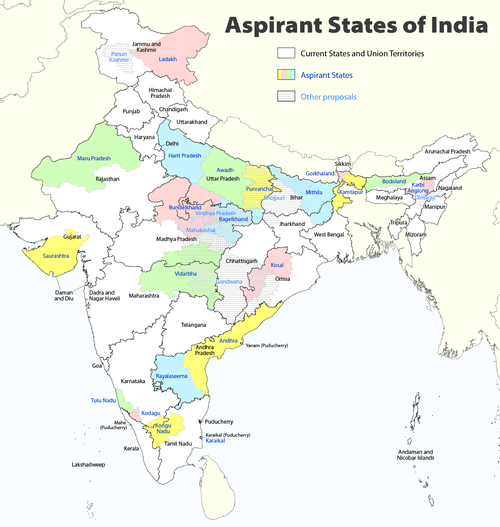Purvanchal
| Eastern Uttar Pradesh पूर्वांचल | |
|---|---|
| Region/Aspirant state | |
| Country |
|
| Region | North India |
| Proposed Capital | Gorakhpur Varanasi |
| Split divisions | |
| Language | Hindi, Urdu, Bhojpuri, Awadhi |




Purvanchal is a geographic region of northern India, which comprises the eastern end of Uttar Pradesh state where Hindi, Bhojpuri is the predominant language. It is bounded by Nepal to the north, Indian state Bihar to the east, Bagelkhand region of Madhya Pradesh state to the south, the Awadh region of Uttar Pradesh to the west and the end of Lower Doab[1] (Kanpur-Fatehpur-Allahabad region) in Uttar Pradesh to its southwest.
Purvanchal consists mainly of 4 divisions: the eastern-Awadhi region in the west, the western-Bhojpuri region in the east, the Baghelkhand region in the south, and the Nepal region in the north. It lies on the Indo-Gangetic plain, and together with western Bihar is the most densely populated area in the world. The rich quality of soil and the high earthworm density in the soil versus adjoining districts of Uttar Pradesh is favourable for agriculture. Most of the countryside is given to intensive agriculture. Bhojpuri is the predominant language or dialect in the region, in addition to Hindi, although Awadhi and Baghelkhandi are also spoken in the western and southern areas. Like Bihar state to the east, a large population, slow economic growth, agricultural mechanisation, and the closure of sugar mills have led to increased unemployment, social and political discontent, and some unrest in the region.
There has been a political demand to create a separate state by carving out 17 districts in eastern part of present State of Uttar Pradesh. The Purvanchal area is represented by 30 Members of Parliament to the Lok Sabha and 117 legislators in the 403 member Uttar Pradesh state assembly or Vidhan Sabha.
Varanasi is the most prominent city of Purvanchal along with Gorakhpur among all districts. Varanasi is sought to be most possible capital of Purvanchal, while Gorkahpur is another city is less political and but industrially active.
In 1991 the government of Uttar Pradesh established the Purvanchal Vikas Nidhi, to fund regional development projects that advance balanced development, meet local needs, and redress regional disparities. But due to corrupt distribution channels, the conditions have remained still the same.
Languages used in Purvanchal
In Purvanchal, a large number of people speak Bhojpuri.
Regions of Awadh in Purvanchal

History of Purvanchal
Historically Purvanchal is the region ruled by the king of Kashi (Kashi Naresh), which reigons are Mirzapur, Chandauli, Ballia, Mau, Ghazipur, Sonbhadra, Deoria, Kushinagar, Azamgarh, Jaunpur, Bhadohi, some parts of Gorakhpur, Basti and also Sant Kabir Nagar.[2] This territory was ruled by the Bhumihars, which have their strong army to support them.[2] The Kingdom of Kashi was founded by Khsetravridha, the son of Ayus, of the Somavansa dynasty of Pratishthana. It lost independence in 1194 and was eventually ceded by the Nawab of Oudh to the British Raj in 1775, who recognized Benares as a family dominion. Benares became a state in 1911[2]. It was given the privilege of 13-gun salute.
The kingdom of Benares currently known as Varanasi was recaptured from Nawab of Oudh by Mansa Ram, a Gautama clan Bhumihar zamindar of Utaria.[2] In 1737 AD Balwant Singh, ruler of Utaria, later captured the territories of Jaunpur, Varanasi and Chunar in 1740 AD from the Mughal Emperor of Delhi.[2] The Kingdom of Benaras started to hold prominence in this way during the Mughal dynasty. Other prominent places under the kingship of Kashi Naresh were Chandauli, Gyanpur, Chakia, Latifshah, Mirzapur, Nandeshwar, Mint House and Vindhyachal.[2]
With the decline of the Mughal Empire, the military of Bhumihar Brahmins strengthened their sway in the area south of Avadh and in the fertile rice growing areas of Benares, Gorakhpur, Deoria, Ghazipur, and Ballia and on the fringes of Bengal.[2] The strong clan organisation on which they rested, brought success to the lesser Hindu princes. There were as many as 1,00,000 Bhumihar clansmen backing the power of the Benares rajyas in what later became the districts of Benares, Gorakhpur and Azamgarh.[2] This proved a decisive advantage when the dynasty faced a rival and the nominal suzerain, the Nawab of Awadh, in the 1750s and the 1760s.[2] An exhausting guerrilla war, waged by the Benares ruler against the Avadh camp, using his clan troops, forced the Nawab to withdraw his main force.[2]
According to Orthodox Bhumihar Brahmin traditions, no one has seen Kashi Naresh eat food, and none of the kings have travelled abroad, in keeping with strict Brahmin rules.[3] Kashi Naresh has played host to a list of dignitaries which includes Bishweshwar Prasad Koirala, Pandit Jawaharlal Nehru, Rajendra Prasad, Indira Gandhi, Queen Elizabeth, Nelson Mandela, the Dalai Lama, President Kocheril Raman Narayanan and his Burmese wife.[3]
About Purvanchal

Purvanchal is one of the most ancient regions of India and enjoys a rich heritage and culture, particularly because of its association with cities like Varanasi, Gorakhpur etc. However, the economic and industrial growth of this region had been greatly hindered because of caste-guided political in-fighting and a huge population. The major issues are lack of civic infrastructure, proper rural education and employment. Bleak law and order is a major area of concern. Negligence on the part of Uttar Pradesh government and Central Government of India have also added to its present condition of chaos.
The region played a very important role in the freedom struggle of India. It was for this reason that Britishers were always apprehensive of the strong nationalist and pro-independence spirit of the people. Mangal Pandey is one of the most prominent freedom fighters from this region, known as the true son of Purvanchal. In popular culture, Purvanchal is well known as "The land of warriors". Hinduism and its subsets Buddhism and Jainism also owe their origin to this region only.
GI tag holders Sant Ravidas Nagar, Bhadohi and Mirzapur are major players in the carpet manufacturing in Asia. Another GI tag holder district Varanasi is a center of Indian tourism and special sari manufacturing. Sonbhadra, a district of Purvanchal, Uttar Pradesh produces 7000 MW electricity, almost half of the total electricity generation in the state of Uttar Pradesh and largest and only major mine of limestone in India. Varanasi and Kushinagar attract more than 65% of the total tourists visiting Uttar Pradesh. Mirzapur and Sonbhadra are very rich with natural resources. t
List of districts in Purvanchal
Purvanchal includes the following 17 districts from Uttar Pradesh[4]
Purvanchal May Include these districts from western Bihar.
Bhojpur, Rohtas, Buxar, Kaimur, East & West Champaran, Saran, Siwan and Gopalganj.
Education

The region of Purvanchal, Uttar Pradesh, had a long tradition of learning, although it had remained mostly confined to the elite class and religious establishments. Sanskrit-based education comprising the learning of Vedic-to-Gupta periods, coupled with the later Pali corpus of knowledge and a vast store of ancient-to-medieval learning in Persian and Arabic languages, had formed the core of Hindu-Buddhist-Muslim education, until the rise of British power. The present schools-to-university system of education owes its inception and development here, as in the rest of the country, to foreign Christian missionaries and the British colonial administration.
Banaras Hindu University is a Central University in Varanasi.[5] It evolved out of the Central Hindu College of Varanasi, set up by Annie Besant — a colorful British woman of Irish descent — who joined hands with Pandit Madan Mohan Malaviya in April 1911 for a common Hindu university at Varanasi. The Banaras Hindu University started functioning from 1 October 1917, with the Central Hindu College as its first constituent college. Most of the money for the university came from Hindu princes and its present 1,350-acre (5.5 km2) campus was built on land donated by the Kashi Naresh. Regarded as the one among the largest residential universities in Asia,[6] it has more than 128 independent teaching departments; several of its colleges — including science, linguistics, law, Management (FMS-BHU) and medicine (IMS-BHU) — are ranked amongst the best in India.[7] The university's enrollment stands at just over 15,000, including international students.
Indian Institute of Technology (Banaras Hindu University), Varanasi is an Institute of National Importance in Purvanchal. It is one of the 16 prestigious Indian Institutes of Technology. It was established in 1919 by the visionary Mahamana Pandit Mohan Malviya and has been constantly ranked among the top 10 technical institutes of India.
A Government Degree College was set up by the Government of Uttar Pradesh, for providing higher education to scholars who are interested in course work and programs of higher studies. At present, 137[8] Government Degree Colleges have been established by the state government to fulfill above criteria. The UP government[9] administers, manages and controls these colleges through Department of Higher Education, Uttar Pradesh[10] and follows the norms and regulations of University Grants Commission, New Delhi.,[11] National Seed Research and Training Centre, Varanasi,[12] Jamia Salfia Darul-Islamia, islamic University, Varanasi[13]
Major universities
- Banaras Hindu University (BHU), Varanasi, Central University, India
- Indian Institute of Technology (BHU) Varanasi
- Madan Mohan Malaviya University of Technology, Gorakhpur
.jpg)

- Deen Dayal Upadhyay Gorakhpur University, Gorakhpur
- Purvanchal University, Jaunpur
- Mahatma Gandhi Kashi Vidyapeeth, Varanasi
- Central Institute of Higher Tibetan Studies, Varanasi
- Sampurnanand Sanskrit University, Varanasi
- Mahatma Gandhi Kashi Vidyapith, Varanasi
Major Engineering, Medical & Research Institutes in Purvanchal
- [[Madan Mohan Malaviya Engineering University <ref>wikipedia</ref>]], Gorakhpur
- Baba Raghav Das Medical College, Gorakhpur
- Indian Institute of Sugarcane Research, Gorakhpur
- National Seed Research and Training Centre, Varanasi
- Hanuman Prasad Poddar Cancer Hospital and Research Institute, Gorakhpur
- Government Medical College, Azamgarh
- Udai Pratap Autonomous College, Varanasi
- Central Hindu College, Varanasi
- Imania Arabic College, Varanasi
- Indian Institute of Carpet Technology, Sant Ravidas Nagar, Bhadohi
- Indian Institute of Handloom Technology, Varanasi
- Ayurved Mahavidyalaya, Varanasi
- Government Engineering College, Azamgarh
- Jaunpur medical college(under construction)
Economic Zone
Tourist attractions



- Varanasi
- Kushinagar
- Gorakhpur
- Jaunpur
- Gorakhnath Temple (Gorakhpur)
- Kapilvastu
- Sita Mata Samahit Sthal, Sitamadhi(BHADOHI)
- Salkhan Fossils Park
- Siddharthnagar District
- Shivdwar Temple
- Sonbhadra
Important Roads, Railways and Airports
Major Roads
- NH-2,
- National Highway 7 (India)(old numbering),
- NH-19,
- NH-233B,
- NH-28,
- NH-29,
- NH-56,
- NH-97,
- Golden Quadrilateral
Airports
- Lal Bahadur Shastri International Airport, Varanasi
- Gorakhpur Airport
- Kushinagar Airport
- Shravasti Airport
- Azamgarh Airport
- Lucknow Airport
Notable people from Purvanchal
See also
References
- ↑ Doab
- 1 2 3 4 5 6 7 8 9 Bayly, Christopher Alan (1983). Rulers, Townsmen, and Bazaars: North Indian Society in the Age of British Expansion, 1770–1870. Cambridge University Press. p. 489 (at p 18). ISBN 978-0-521-31054-3.
- 1 2 Mark Manuel. "Nobody's Seen The Gourmet Maharaja Eating!". Upper Crust. Archived from the original on 2007-11-10. Retrieved 2008-04-08.
- ↑ "Proposed Purvanchal Map". Retrieved 19 June 2016.
- ↑ "University at Buffalo, BHU sign exchange programme". Retrieved 19 June 2016.
- ↑ "Banaras Hindu University" (PDF). Indian Academy of Sciences. 2005-07-26. Retrieved 2007-04-19.
- ↑ Raj Chengappa (2008-05-22). "India's best colleges: India Today". Indiatoday.intoday.in. Retrieved 2010-07-18.
- ↑ "High Education Department". Retrieved 19 June 2016.
- ↑ http://upgov.nic.in/
- ↑ "Higher Education Department". Retrieved 19 June 2016.
- ↑ http://www.ugc.ac.in/policy/englishgazette.pdf
- ↑ http://www.nsrtc.nic.in/
- ↑ "Al Jamia Tus Salafiah – Varanasi, India". Retrieved 19 June 2016.
External links
 |
Nepal, Awadh (Uttar Pradesh) | Nepal | Nepal, Bihar |  |
| Awadh (Uttar Pradesh) | |
Bihar | ||
| ||||
| | ||||
| Lower Doab (Uttar Pradesh) | Bagelkhand | Jharkhand |
